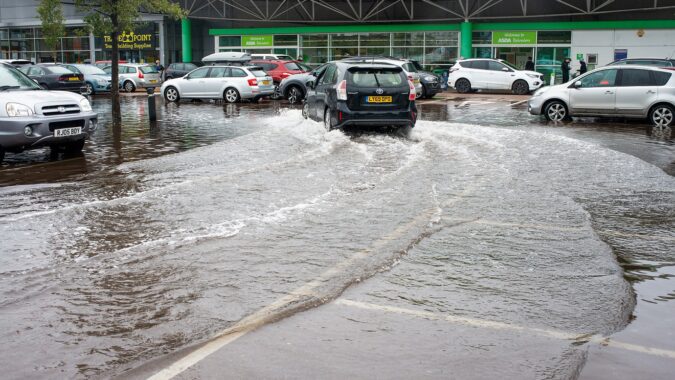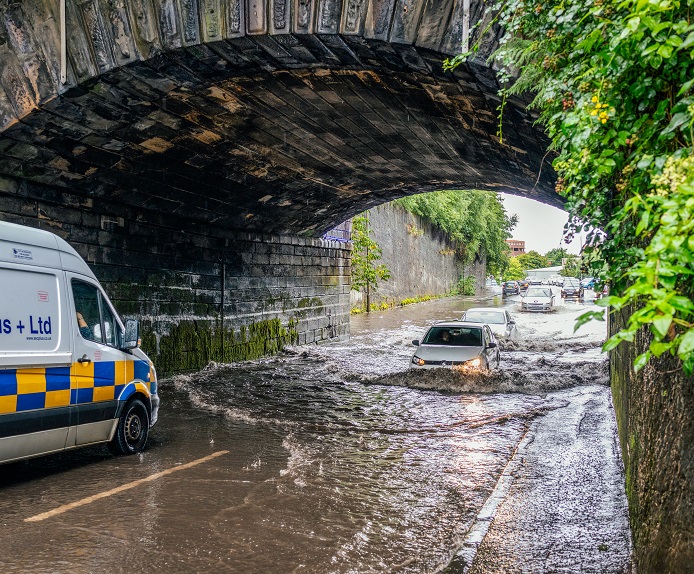Surface water flooding
Status:Final report complete. Published:
A study on effective approaches to the management of surface water flooding in England.
Summary
In October 2021, the government asked the Commission to conduct an assessment of how responsible bodies in England can better manage and mitigate surface water flooding.
The final report – Reducing the risk of surface water flooding – was published on 29 November 2022. The government responded formally to the study in March 2024.
The work of the study included:
- analysis of the current risks of surface water flooding (including sewage overflows) and the opportunities that exist to address these in the short and long term
- recommendations concerning improvements needed to England’s drainage systems to manage and prevent surface water flooding in both urban and rural economies, including through nature-based solutions alongside hard engineering
- consideration of the optimum cost-benefit analysis of infrastructure options and how these can be combined to provide greater resilience and value for money.
This now-completed study covered England only, as flooding and water management is a devolved function.
The Commission liaised with flood risk management authorities to carry out the study, and consulted infrastructure providers, engineering sector and environmental NGOs to maximise the breadth of understanding and opportunities.
The Call for Evidence to support the scoping and research phase of the project closed on 20 December 2021.
Next Section: Terms of reference
The National Infrastructure Commission (NIC) will conduct a study on effective approaches to the management of surface water flooding in England.
Terms of reference
The National Infrastructure Commission (NIC) will conduct a study on effective approaches to the management of surface water flooding in England.
Surface water flooding is caused by a combination of factors including rainfall, soil permeability, drainage system capacity and maintenance, and physical barriers. It is often localised, complex, disruptive to homes and business and can cause serious pollution to rivers and coastal waters with impacts on environmental quality, biodiversity, and public health and amenities.
Surface water flooding is the most common flood risk in England, with 3.2 million properties at risk (62 per cent of those at risk of flooding). With more intense rainfall, climate change and population growth we are at greater risk of surface water flooding, with significant incidents occurring this year.
Effective surface water flooding solutions are likely to require a holistic approach to water management at both local and landscape scale with actions needed across a range of sectors and including both built infrastructure and nature-based solutions.
The final report of this study – Reducing the risk of surface water flooding – was published in November 2022. It provides a robust assessment, based on evidence and economic impact, of how responsible bodies can better manage and mitigate surface water flooding through outcomes and actions, including through infrastructure.
The terms of reference for that study included:
Undertaking analysis to gain a better understanding of the risks of surface water flooding (including sewage overflows) and the opportunities that exist to address these in the short-term (circa five years including informing the next water company price review) and long-term (circa 25 years)
Determining the role of and improvements needed to England’s drainage systems to manage and prevent surface water flooding in both urban and rural economies in the short-term and long-term. This will include opportunities for harnessing nature-based solutions, such as sustainable urban drainage systems (SuDS), other blue-green infrastructure, and natural flood management, alongside hard engineering solutions such as sewer system design and / or capacity retrofitting.
An assessment of current approaches to manage surface water and exploring the options for ensuring the optimum mix of short and long-term actions are being taken, including considering the optimum cost-benefit analysis of each infrastructure option and how these can be combined to provide greater resilience and value for money. This may also include improving current levels of governance, performance, preparedness and understanding, local flood planning, spatial and development planning, data sharing, funding and investment.
This study will cover England only, as flooding and water management is a devolved function. The government expects flood risk management authorities to support the Commission as it carries out the study through sharing available data. In undertaking the study, the NIC should also work with infrastructure providers, engineering sector and environmental NGOs to maximise the breadth of understanding and opportunities.
This study will focus on infrastructure and so will not cover actions such as individual behaviour change and advanced weather forecasting, as these are outside the remit of the NIC.
The NIC should deliver a final report to government by November 2022, setting out recommendations to government. All recommendations should be consistent with the Commission’s current fiscal and economic remits.
Next Section: Call for evidence
The Call for evidence closed on 20 December 2021
Call for evidence
The Call for evidence closed on 20 December 2021
Use the button below to read the Surface Water Flooding Call for Evidence online or to download a copy of it.
It sought evidence in response to fifteen questions grouped under these themes:
- Understanding the size of the problem
- Infrastructure solutions
- Behaviour change and resilience
- Governance and decision making
- Funding and finance.
Final report
The final report of this study was published on 29 November 2022. Government responded formally to the Commission’s recommendations in March 2024.
Read the full online version of the report, Reducing the risk of surface water flooding. A .pdf of the report is also available to download.
Next Section:
The final report of this study makes nine recommendations to government on how the management of surface water flooding by responsible bodies in England can be improved.
The final report of this study makes nine recommendations to government on how the management of surface water flooding by responsible bodies in England can be improved.
Government should act to mitigate the impact of urbanisation
By the end of 2023, government should implement Schedule 3 of the Flood and Water Management Act 2010 and update its technical standards for sustainable drainage systems.
Drainage systems must be improved to protect properties in the coming decades
Government should undertake a comprehensive review of the effectiveness of all available options to manage unplanned increases in impermeable (or hard) surfaces, and their costs and benefits. By the end of 2024, government should decide whether policy changes are required to reduce the impacts on surface water flooding or adjust investment levels for flood risk reduction accordingly.
Action to identify the places most at risk
Government should:
- require the Environment Agency to use the results of the second National Flood Risk Assessment in 2024 to identify new flood risk areas
- from 2025, require upper tier local authorities, water and sewerage companies, and other relevant authorities in the new flood risk areas to, where necessary, develop detailed local risk maps that can be integrated into the Environment Agency’s national map, and models that can be used to plan future management of surface water flooding.
Government should set national risk reduction targets to drive and monitor progress
By early 2025, government should set a long term target for a percentage reduction in the number of properties at high and medium risk of surface water flooding
Agree local targets by mid 2025
The government should require risk management authorities in the new flood risk areas to agree appropriate local targets by mid 2025
Water and sewerage companies should play a key role in reducing risk
Government should:
- clarify in its strategic priorities for Ofwat that it should enable water and sewerage companies to invest in solutions to manage surface water flooding including sustainable drainage
Single, costed, joint plans
Government should require:
- upper tier local authorities, water and sewerage companies, and, where relevant, internal drainage boards in the new flood risk areas to produce and deliver costed, joint investment plans for managing surface water that achieve the agreed local objectives and follow the ‘solutions hierarchy’
- the Environment Agency to review and assure the final plans with input from Ofwat and support from Regional Flood and Coastal Committees, and publish data on progress against local and national targets
- joint plans to be completed by 2026 and revised every five years following the review of flood risk areas the year before, and to inform the following Ofwat Price Review.
Devolved local funding for local flood risks
By the end of 2025, government should devolve public funding to upper tier local authorities in or containing new flood risk areas, based on the Environment Agency’s assessment of the levels of risk in each new flood risk area. The funding allocation should be reviewed every five years, in line with single joint plan cycles.
There should be support for properties remaining at risk
By the end of 2024, government should explore options for funding property level measures for those properties that remain at high risk of surface water flooding because improving drainage infrastructure is not cost effective.
Latest Updates

Coming up in 2024
This page shows a calendar reflecting the latest expected dates for Commission reports, publications and events. You can also sign up to receive our quarterly newsletter by entering your email address in the box at the foot of each website page.

Commission welcomes move to more sustainable drainage for new developments
The government has today (10 January 2023) announced its intention to implement Schedule 3 of the Flood and Water Management Act in England (subject to consultation). This shift in policy will make sustainable drainage solutions the default for almost all new developments in England, and make the right to connect surface water runoff to public...

600,000 properties face future flooding without action to reduce urban runoff and improve drainage systems
Stricter controls on new property developments alongside up to £12bn of investment in drainage infrastructure over the next thirty years will be necessary to stop thousands more homes and businesses from flooding due to inadequate drainage, according to a new report by the National Infrastructure Commission. Localised floods across England last month alongside a series...

Reducing the risk of surface water flooding
The final report of the study on surface water flooding concludes that stricter controls on new property developments alongside up to £12bn of investment in drainage infrastructure over the next thirty years will be necessary to stop thousands more homes and businesses from flooding due to inadequate drainage
